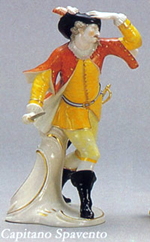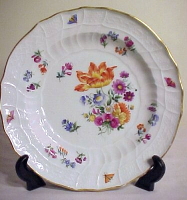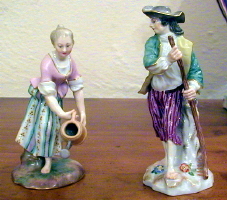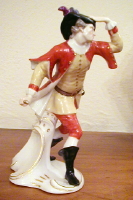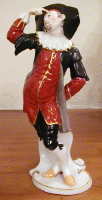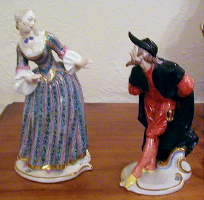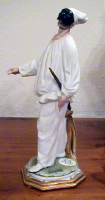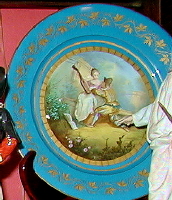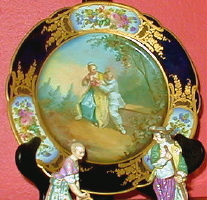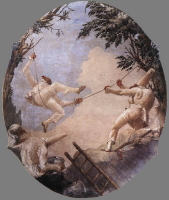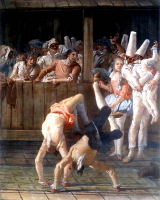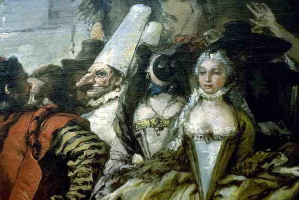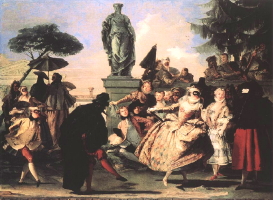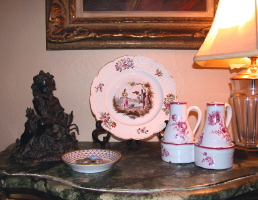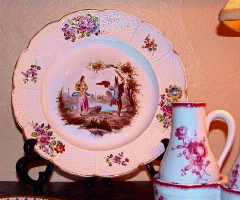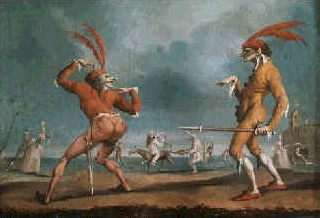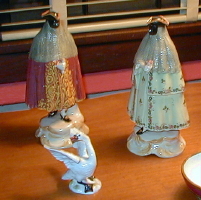"Collectors are not born
- they are taken hostage!"
Anonymous

For me, it was a convergence of my love for art and
art history with the opportunities to live in Europe and Asia,
from which much later emerged a related interest in European antiques
and historical architecture and gardens.
My
love of art goes back to childhood with my grandfather, who was an
artist;
and I have held a love for art history since a freshman in college.
It was these fields which I turned to, when I left my career in psychology,
fairly burned out,
to find something positive to enrich
my life.
When Tom and I arrived in Washington, I took a two-year "personal
sabbatical," just to study art:
I took drawing and painting clases and art history studies at the
National Art Gallery.
This activity later led me to study European antiques.
Tom was interested in many of these things too.
So, he took a course in "Connoisseurship" at the Smithsonian;
and, when opportunities presented themselves in Washington and New
Jersey, we gradually started collecting.
Continental
Porcelain
One does not live long in Germany, without hearing
their pride in Meissen porcelain,
which is referred to as "white gold!"
But, it took me nearly 20 years, to have a chance to dig into the
subject enough
to learn what all the excitement was about.
Click image to
enlarge.
A
19th C Meissen plate, "Deutsche Blumen" (German Flowers)
We have a growing dinner service in this pattern now.
Inspired by a Meissen plate which was given to me as a farewell gift
by a German woman, in 1969,
I began seriously studying antique porcelain while living in Washington,
around 1986.
I soon began dragging Tom off to antique shows to see it, so I could
learn about it first-hand.
On seeing and handling pieces of Meissen, he thought it was neat stuff
and took an interest.
We were often accompanied by our friends the Sue and Bob, who had
begun their own porcelain collection
during their earlier years in Germany. (See Friends section on the
Index page.)
Their collection was also an inspiration for us.
A year or so later, Tom and I purchased our first piece of Meissen:
a humble plate was all we could afford, but, it was a start.
Real progress came with the arrival of eBay,
where prices were relatively low in the early years,
and much was available from collectors and dealers around the globe.
We have expanded our interest in porcelain over the years to include
some other factories
in Germany and France, which rose to compete in quality in later years.
It would be another decade, before this would lead to my special interest
in selling antique European ceramics.
We now find ourselves increasingly specializing in certain kinds of
design and subject matter,
as you will see here. Our current collection of porcelain is primarily
from
Meissen, Sevres (France) and Nymphenburg (Bavaria).
Each piece was originally hand-sculpted by a porcelain modeler and
then painted by hand.
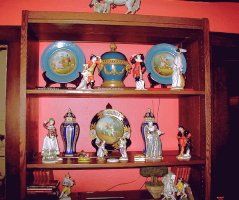 |
Click
image to enlarge.
(Pardon
the harsh lighting above! I took the photo at night with a strong light.)
The blue pot pourris on the top shelf is 18th century
Chinese porcelain
with 19th century French bronze mounts...
a special interest of mine that uniquely combines my loves of things
oriental and French!
The plates and small urns are a mixture of
18th and 19th C French porcelain by the Royal Sevres factory.
The
tiny gardener couple (center of second shelf) is
by Meissen, 18th and 19th C.
She's the older one! Fitting, yes?!
For those who
have never held a Meissen figure in their hands,
this is dense, heavy porcelain with a very solid feel. It is the whitest
of porcelain.
The quality and detail of the modelling and painting are the best
in the world.
Each figure is a fine sculpture in porcelain. The other figures are
characters in the...
Italian
Commedia dell' Arte
Tom and I have also long held an interest in
the Italian Comedy.
Love of theatre was something that originally drew
us together.
We even spent our honeymoon at the G.B. Shaw Festival in Canada.
This mutual interest has considerably effected our collecting.
One of our earliest goals as collectors was to acquire porcelain
figures
of characters of the Commedia dell' Arte,
upon which many of the classical characters of theatre are based.
|
Commedia
Dell'Arte is the ancient Italian improvisational masked comedy
born in the Renaissance and performed until the first half of
the eighteenth century.
Troupes traveled city to city earning their living by performing
comedies, farces, parodies and political satires in the streets,
markets, and at carnivals and fairs. The performers drew from
every day life material for their shows, harping on every class,
custom, and law.
The stock characters were universally identified by their individual
costumes and masks and never changed regardless of how the scenario
developed. The masks, usually leather, were inseparable from
the actor throughout the performance, even if the character
changed costumes.
The mask is the driving force behind each character's unique
movements and dialect.
The scenarios usually centered around the misfortunes of Pantalone,
the senile old man, or a love triangle between the lovers and
another character (Il Capitano, Arrlechino, or Il Dottore).
Reference:
Doug Cummins, Professor, Department of Theatre Arts Furman University
Greenville, SC
|
Most
people are familiar with some of the best known commedia characters,
such as Harlequin (Arrlechino),
Pierrot and Pulcinello.
Along with the stock characters of Greek tragedies, these Italian
characters
are the basis for all, classical theatre roles.
Up-dated forms of the characters can be seen in modern theatre and
film of today.
Most notably in recent times, Stephen Spielburg has acknowledged
that he based some of his films on the Commedia themes and characters.
Our
Commedia Figures
All but one of the large figures on the shelves are 19th C creations,
based on the 18th century originals by Bustelli of the Royal Nymphenburg
porcelain factory in Munich, Germany.
The Bustelli
models are considered by art historians to have been the best of any:
unique and exquisite in the amount of movement and interaction displayed
between them.
Pulcinella
(right
end on the upper
shelf above) is by Italy's Capodimonte,
the rest are from the Nymphenburg series, which we
are slowly collecting, one at a time.
Click
images to enlarge.
Capitano, Harlequina,
Dottore
Click
images to enlarge.
Isabella and
Pantalone (a pair), Pulcinella
In April
2005 we were able to see some of the original Bustelli commedia figures,
on display at museums in Munich and at the Nymphenburg
palace,
which still houses the porcelain factory.
What a thrill!!
I'll try to get some photos posted of those one of these
days.
Click
images to enlarge.
Mezzetino
(Mezzetin in France), shown left above on an 18th century Sevres
plate,
was a wandering minstrel of the Commedia who, like all of the male
characters,
often got into mischief. On the other plate (19th C. Sevres)
is an amorous Pierrot.
Click
images to enlarge.
We purchased the Capodimonte Pulcinella in Venice,
in memory of the wonderful frescos of him by Giandomenico Tiepolo
at Ca' Rezzonico in Venice (left
and center above) and at Villa Valmarana, Vicenza
,
which we were thrilled to see during our trip to Italy in 2001.
(Photos of Venice coming soon to our travel section!)
Below is his Minuette of Pantalone and Columbina.
Click
image to enlarge.
Click
images to enlarge.
The
"Zannis" of the Commedia
are represented on this 18th-century-French faience plate above.
Here we have a Zanni with Isabella, taken from a 16th century engraving
by Callot.
|
Zannis are the lowest in society and usually servant to the
Vecchi.
A typical zanni is stupid, always falls asleep
on the job, steals food, or is caught daydreaming. Their drive
is sex and hunger. He or she assists the plot in moving along
by confusing matters with whatever task they are assigned. But
they do save the show from boredom by providing slapstick comedy,
lazzi, when they encounter each other.
Reference:
Doug Cummins (see above)
|
Above
is an anonymous, 18th century Venetian painting of Zannis, after
another Callot work.
Venice
As our love of the above frescoes might suggest, once
we got into the Commedia,
it was a short leap to an interest in Venice Carnival and,
from there, to 18th century Venice and its art!
Click
image to enlarge.
These
are two of my favorites! They are very, very rare!
A large pair of 18th Venetian figures by the Nove factory in
the Veneto.
Their masks and costumes are still seen at Venice Carnivals of today,
along with costumes of the Commedia characters.
The swan is a 19th C Kaendler model from Meissen.
For
more about the Commedia dell' Arte
Click
here
and here
Continue
with Collections
Click
here
Page
6, House
